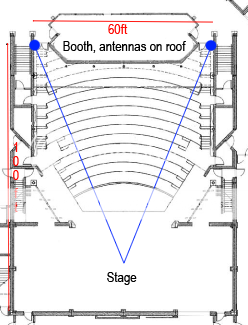zuixro
Active Member
I know there have been a lot of wireless mic threads lately, and everyone's probably tired of them, but I have a question about directional antennas.
(Yes, it's antennas when it's radio, antennae is biology, Antenna - Wikipedia, the free encyclopedia , I just learned that)
We are getting a new wireless mic system soon (Hopefully Shure UHF-R, but probably ULXP). I was looking at permanently (or semi-permanently) mounting directional antennas in our space.
I've seen at least three different configurations for directional antennas:
1. Several feet apart, one a few feet higher than the other. This one was used parallel to the stage.
2. Right next to each other, one turned at a right angle to the other.
3. Spaced 20+ feet apart and pointed at the stage.
Which is the best way to set up the antennas? (or does it depend on the circumstances) Is there anything wrong with any of these? Number 2 seemed a little weird to me, but I can see how it would work. I don't know what the vertical spread is on these antennas are, but if it's small, that could help.
By the way the antennas I am talking about are like this:
Shure UA870USTV UHF Antenna,Wide Band 470-698 | Full Compass
I was thinking about setting up the antennas like this:

Blue dots are antennas, blue lines are where they are pointed.
They would be about 60 feet apart, 25 feet above the deck, and 60-100 feet from the transmitters (these measurements are rough, I'm going by the drawing on our website, and having to figure out some unwritten dimensions)
If that doesn't look good, what is the ideal spacing between the antennas? (I suspect it has more to do with the angle and where they "converge" than the actual spacing) We have a long, narrow wooden wall along the back so we can mount them any distance apart. (actually we will probably end up putting them on mic stands on the balcony, but the question is the same)
I want to go with directional antennas because we had some RF problems with our last musical (probably from the TV station on campus, but I'm not sure).
(Yes, it's antennas when it's radio, antennae is biology, Antenna - Wikipedia, the free encyclopedia , I just learned that)
We are getting a new wireless mic system soon (Hopefully Shure UHF-R, but probably ULXP). I was looking at permanently (or semi-permanently) mounting directional antennas in our space.
I've seen at least three different configurations for directional antennas:
1. Several feet apart, one a few feet higher than the other. This one was used parallel to the stage.
2. Right next to each other, one turned at a right angle to the other.
3. Spaced 20+ feet apart and pointed at the stage.
Which is the best way to set up the antennas? (or does it depend on the circumstances) Is there anything wrong with any of these? Number 2 seemed a little weird to me, but I can see how it would work. I don't know what the vertical spread is on these antennas are, but if it's small, that could help.
By the way the antennas I am talking about are like this:
Shure UA870USTV UHF Antenna,Wide Band 470-698 | Full Compass
I was thinking about setting up the antennas like this:

Blue dots are antennas, blue lines are where they are pointed.
They would be about 60 feet apart, 25 feet above the deck, and 60-100 feet from the transmitters (these measurements are rough, I'm going by the drawing on our website, and having to figure out some unwritten dimensions)
If that doesn't look good, what is the ideal spacing between the antennas? (I suspect it has more to do with the angle and where they "converge" than the actual spacing) We have a long, narrow wooden wall along the back so we can mount them any distance apart. (actually we will probably end up putting them on mic stands on the balcony, but the question is the same)
I want to go with directional antennas because we had some RF problems with our last musical (probably from the TV station on campus, but I'm not sure).


